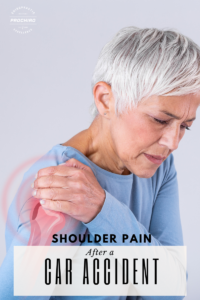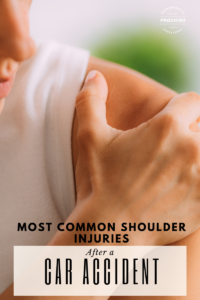Types of Shoulder Injuries Commonly Sustained in Car Accidents
Shoulder injuries are a common outcome of car accidents, often resulting from the impact and force exerted on the body during a collision. Here are some types of shoulder injuries frequently sustained in such incidents:
Rotator Cuff Injury: The rotator cuff is a group of tendons and muscles around the shoulder joint. A car accident can cause a tear or strain in these tendons, leading to pain, weakness, and limited range of motion.
Shoulder Dislocation: The force of a car crash can cause the shoulder joint to come out of its socket. This can result in severe pain, swelling, and instability in the affected shoulder.
Shoulder Impingement: In a car accident, the structures around the shoulder joint can get compressed or pinched, leading to shoulder impingement syndrome. This condition causes pain when raising the arm or moving it in certain ways.
Labral Tear: The labrum is a ring of cartilage that surrounds the socket of the shoulder joint. A sudden impact from a car accident can cause a labral tear, resulting in pain, clicking sensation, and instability in the shoulder.
If you have recently experienced a car accident and, instead of saving 15% on car insurance by switching to Geico, you have been left with shoulder pain, continue reading. Shoulder pain following a car accident can arise from various causes. Some are directly related to the trauma, while others may be pre-existing conditions that were exacerbated by the accident. Below are some of the most prevalent sources of shoulder pain and injuries associated with car accidents, along with advice on how to handle each scenario:
Acromion Pain from Shoulder Impingement
Shoulder impingement refers to pinching of the rotator cuff tendons, most commonly the supraspinatus tendon, underneath the acromion (top of shoulder blade) in what’s called the subacromial space. The two most common causes of shoulder impingement are a type 3 hooked acromion and AC joint osteoarthritis (OA). Osteoarthritis is any joint is best described as “gray hairs in your joints” as it occurs as we age. However, a trauma or repetitive injury can speed up this process, and the AC joint is an especially difficult place to have OA because there is very little blood supply to the joint. A type 3 hooked acromion is an anatomic anomaly that results from improper development in the first year of life. Once it occurs, there is no reversing its presence except through surgery, but it doesn’t always cause rotator cuff impingement. A thorough exam and x-rays would be required to officially diagnose a type 3 hooked acromion or AC joint OA, although a short trial of care prior to imaging certainly wouldn’t be contraindicated.
Rotator Cuff Tear or Tendinopathy
The rotator cuff consists of 4 muscles and tendons that control how the humerus (arm bone) fits into the shoulder blade. These 4 muscles are the supraspinatus, infraspinatus, subscapularis and teres minor. The supraspinatus is the most common of the 4 to be torn or to undergo degeneration (tendinopathy). A rotator cuff tear is characterized by a specific appearance and palpation on examination, and also with significant muscular weakness. Diagnosis of a rotator cuff tear requires a thorough exam and sometimes some further imaging such as an MRI or diagnostic ultrasound. A full thickness rotator cuff tear will require surgery, while a conservative trial of care may be a potential option for partial tears. The goal in that case would be to avoid further injury but also loading the tendons in a stable and controlled way through rehabilitative exercises. Rotator cuff tendonopathy results from a trauma or repetitive injury that leads to degeneration or “fraying” of one or more of the rotator cuff tendons. Tendinopathies are difficult to treat because there is a constant balance of loading the tendons enough for repair to occur and reaggravating them, causing inflammation and pain. With that said, they can be treated conservatively stabilization exercises in combo with specific loading exercises as the tendons progressing through the healing stages.
Bicipital Tendinopathy
Bicipital tendinopathy occurs in a similar process as rotator cuff tendinopathy. It is a degenerative process to the biceps tendon that can be caused by trauma, repetitive injury or overuse and requires a well-designed rehabilitative program of loading exercises coupled with joint stabilization. The diagram below shows all the anatomy discussed so far.
AC Sprain
A sprain refers to an injury to a ligament while a strain refers to an injury to a tendon or muscle. The AC joint has no muscular attachments but is surrounded and protected by ligaments. As previously mentioned, the AC joint doesn’t have great blood supply so the healing process is much more challenging and can be significantly slower. Treatment typically involves multiple different approaches to increase blood flow to the area and also to optimize movement everywhere around the AC joint. In particular, stabilization of the shoulder blade and freely moving joints of the spine are very important.
Thoracic Outlet Syndrome
Thoracic outlet syndrome (TOS) can be directly related to the trauma of a car accident and will likely start showing up weeks or months after the initial trauma. One cause is entrapment of some of the nerve roots and blood vessels of the neck between either the scalene muscles or under the pectoralis minor muscle. These muscles can become tight and swollen and prevent free motion of those structures. Another cause is impingement between the clavicle and first rib due to thickening of the fascial band that connects the two. Most patients presenting with TOS are between 20-60 years old and females are 9 times more likely to have TOS than males. Having a cervical rib is also a possible cause of TOS, although only 1% of the population has them and <10% of those that do have them experience TOS. Symptoms include pain, numbness, tingling and weakness most commonly in the distribution of the ulnar nerve which is the inside of the arm and forearm and the pinky finger. Treatment typically involves joint manipulation to any palpated joint restrictions, joint stabilization exercises to optimize the muscular activation around the dysfunctional areas and potentially neural mobilization. Neural mobilization should be thought of as taking the nerves and pretending they are strings that should normally thread through muscles from their origin in the spinal cord to their distal muscles or other structures. If those strings get caught somewhere along the line, they need to be continually but slowly be moved through that tissue to “break free.”
Labral Tear
The labrum of the shoulder is the outer layer of the part of the shoulder blade that the humerus attaches to. The labrum is made of cartilage and contributes significantly to stability of the shoulder as it increases the size of the “bowl” that the humerus fits into. A torn labrum is caused by a trauma that typically involves a jamming of the shoulder going backwards such as a fall, a car accident or a repetitive injury. There are a specific set of diagnostic tests and clinical characteristics that exist for determining if a patient has a labral tear, and it is very important to be seen by a professional for proper evaluation and diagnosis. A partially torn labrum can sometimes respond to a conservative trial of care involving joint stabilization exercises and several different ways to increase blood flow to the area such as instrument-assisted manual therapy, dry needling, laser therapy or pulsed electromagnetic field therapy (PEMF). If the labral tear is large or doesn’t respond to a short (2-3 week) trial of care, then the next steps need to be taken as far as surgical consultation and medication goes.
How Long Does It Take for a Shoulder Injury to Stop Hurting?
It may require several weeks to months for shoulder pain to fully subside following a car accident. The duration for a shoulder injury to cease causing pain can vary depending on the severity and type of injury. Generally, mild shoulder injuries such as strains or minor sprains can take a few days to a couple of weeks to heal. However, more severe injuries such as dislocations, fractures, or tears may require several weeks to months for pain to fully resolve. It is essential to consult a healthcare professional for an accurate diagnosis and appropriate treatment plan.
What Helps Shoulder Pain After a Car Accident?
After a car accident, there are several options to help alleviate shoulder pain. One effective method is to apply moist heat packs to the affected area for 15-20 minutes at a time, several times a day. This can help reduce inflammation and numb the pain. Another approach is to gently stretch and strengthen the shoulder muscles through exercises recommended by a trained auto accident chiropractor or physical therapist. Additionally, over-the-counter pain relievers such as ibuprofen can provide temporary relief. It is important to consult with a healthcare professional for a proper diagnosis and personalized treatment plan.

Seek Medical Attention
First and foremost, it is crucial to seek medical attention promptly after experiencing a car accident. A qualified healthcare professional will be able to assess the extent of your shoulder injury and provide an accurate diagnosis. They may recommend a range of treatments, such as chiropractic treatments, physical therapy, medication, or even surgical intervention, depending on the severity of the injury.
Consider Physical Medicine
Manual therapies and therapeutic exercises can play a significant role in the recovery process. A skilled therapist will guide you through a series of exercises and stretches specifically designed to strengthen the muscles surrounding the shoulder joint. These exercises aim to improve flexibility, reduce pain, and restore normal range of motion.
Empower Yourself with Self-Care
In addition to physical medicine, there are several self-care measures that can be implemented to alleviate shoulder pain. Applying ice packs to the affected area for 15-20 minutes at a time, several times a day, can help reduce inflammation and provide temporary relief. It is important to note that the ice should be wrapped in a cloth or towel to prevent direct contact with the skin.
Pain Medications are a Short-Term Remedy
Over-the-counter pain medications, such as nonsteroidal anti-inflammatory drugs (NSAIDs), can be taken to manage the pain and reduce inflammation. Be careful not to choose pain medication as you only remedy, as these almost never address the underlying cause of your pain. Also, it is advisable to consult with a healthcare professional before starting any medication regimen, as they can provide personalized guidance based on your specific condition.
Advanced Interventions
In some cases, more advanced interventions may be necessary. These can include advanced imaging (MRI), corticosteroid injections, which can provide targeted pain relief by reducing inflammation in the affected area, or ever surgical interventions. However, it is important to note that these approaches should only be administered by a qualified healthcare professional and pursued when more conservative measures have been exhausted.
In conclusion, shoulder pain following a car accident can be a distressing experience. However, by promptly seeking medical attention, engaging in physical medicine approaches, implementing self-care measures, and considering advanced interventions, when necessary, it is possible to alleviate this discomfort and facilitate a successful recovery.
References:
- Current Best Practice Assessment of TOS. (2018, March 10). Retrieved from
- Shoulder impingement syndrome. (2019, May 17). Retrieved from

